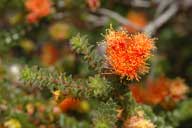In Flower This Week
A news sheet prepared by a Gardens' volunteer.
Numbers before each plant refer to temporary IFTW labels in the gardens.
Numbers in square brackets [ ] refer to garden bed Sections. Plants in flower are in bold type.
View past issues of 'In Flower This Week'.
9 December 2015
Eremaea beaufortioides var. beaufortioides click for larger image |
Today we will walk from the Visitor Information Centre (VIC) along the Main Path to the Grevillea section.
- As you leave the VIC you will notice on your left Pandorea jasminoides [Section 212], or Bower of Beauty, covered in pink flowers and attractive mid-green foliage. This woody vine is native to New South Wales and Queensland.
- On the right wall is Jasminum simplicifolium subsp. suavissimum [Section 221], or Forest Jasmine, with strongly-scented white star flowers on a scrambling green-leaved vine. This plant is native to New South Wales and Queensland.
- Further on your right in a pot is Banksia coccinea [Section 174],with short, bright red cones and grey-green foliage. This plant is native to southwestern Western Australia.
- On your left Dicksonia antarctica [Section 210], or Soft Tree Fern, has magnificent, bright green fronds which unfurl from the chocolate-brown hairy base. This iconic plant is native to southeastern Australia, including Tasmania.
- On your right is Pelargonium rodneyanum [Section 174], or Magenta Storksbill, with small bright pink/purple flowers on green lobed “geranium” leaves. This plant occurs naturally in fragmented populations in New South Wales, South Australia and Victoria.
- Go over the bridge and skirt past the café to follow the Main Path up the hill. On your left is Homoranthus prolixus [Section 10], showing an attractive contrast between the layered grey-green foliage and acid yellow flowers. This plant is listed as vulnerable in the wild and only occurs in areas near Inverell and Bendemeer, New South Wales.
- On your right is Eremaea beaufortioides [Section 9], with close green foliage and bright orange fluffy flowers. It occurs in coastal areas of Western Australia, between Perth and Geraldton.
- On your left is Persoonia mollis subsp. lediifolia [Section 30], a low bush with green foliage and small, tubular yellow flowers. This plant is endemic to New South Wales.
- On the right is Grevillea insignis subsp. insignis [Section 30],a sprawling, open bush with blue-green prickly holly-like leaves with prominent veins. It has large terminal pink/cream blooms with dark red styles and is native to southwest Western Australia.
- On your right is Grevillea ‘Poorinda Adorning’ [Section 27], a prostrate green bush with bright red spider flowers with long styles. This is one of several grevillea cultivars developed from crosses made by Leo Hodge at his property “Poorinda” near Buchan, Victoria.
- Cross the road to see on your right Grevillea ‘LadyO’ [Section 26], a long-blooming shrub with red flowers and bright green foliage. ‘LadyO’ resulted from a cross made by local plant breeder Peter Ollerenshaw between a Grevillea victoriae hybrid and G. rhyolitica.
- Also on your right is Grevillea sericea [Section 26], covered in pink spider flowers on a long-flowering open bush. This plant is endemic to New South Wales.
- Look low on your left to see Grevillea ‘Hunter Beauty’[Section 24], with long green leaves and red toothbrush flowers. Itmay be a hybrid between G. aspleniifolia and G. laurifolia, as it has characteristics of both these species.
- On your right is Grevillea tripartita subsp. macrostylis [Section 26], a large rangy bush with sharp-pointed foliage and large red and yellow flowers. It is native to southern Western Australia.
- Low on your right is Banksia petiolaris [Section 26], a ground-hugging banksia with upright leathery green leaves and a green flowering cone with a dark red core.It isnative to an area around Esperance, Western Australia.
Rosalind Walcott
![Director of National Parks [logo]](../../../../images/dnp_90px.gif)







